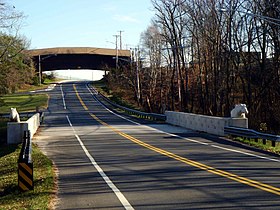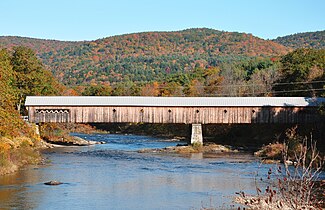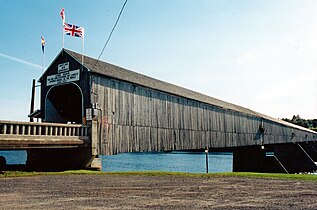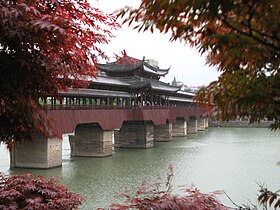Covered bridge
 The Cogan House Covered Bridge, Pennsylvania | |
| Ancestor | Truss bridge, others |
|---|---|
| Related | Tubular bridge, Skyway, Jetway |
| Descendant | None |
| Carries | Pedestrians, livestock, vehicles |
| Span range | Short |
| Material | Typically wood beams with iron fittings and iron rods in tension |
| Movable | No |
| Design effort | Low |
| Falsework required | Determined by enclosed bridge structure, site conditions, and degree of prefabrication |
A covered bridge is a timber-truss bridge with a roof and siding which, in most covered bridges, create an almost complete enclosure.[1] The purpose of the covering is to protect the wooden structural members from the weather. Uncovered wooden bridges typically have a lifespan of only 10 to 15 years because of the effects of rain and sun. The brief moment of relative privacy while crossing the bridges earned them the name "Kissing Bridges".[2]
Bridges having covers for reasons other than protecting wood trusses, such as for protecting pedestrians and keeping horses from shying away from water, are also sometimes called covered bridges.
History and development

Early timber-framed covered bridges consisted of horizontal beams laid on top of piles driven into the riverbed below. However, this construction method meant that the length between bridge spans was limited by the maximum length of each beam. The development of the timber truss circumvented that limitation and allowed bridges to span greater distances than those with beam-only structures or arch structures, whether of stone, masonry, or timber.[3]
Early European truss bridges used king post and queen post configurations. Some early German bridges included diagonal panel bracing in trusses with parallel top and bottom chords.[3] To solve the problem of deterioration of the wood upon exposure to weather, various forms of covering came to be employed.[4]
At least two covered bridges make the claim of being the first built in the United States. Town records for Swanzey, New Hampshire, indicate their Carleton Bridge was built in 1789, but this remains unverified.[5] Philadelphia, however, claims a bridge built in the early 1800s on 30th Street and over the Schuylkill River was the first, noting that investors wanted it covered to extend its life.[6] Beginning around 1820, new designs were developed, such as the Burr, Lattice, and Brown trusses.
In the mid-1800s, the development of cheaper wrought iron and cast iron led to metal rather than timber trusses, except in those areas of plentiful large timber.[3]
Examples of covered bridges

There are about 1600 covered bridges in the world.[7]
Asia
- China: covered bridges are called lángqiáo (廊桥), or "wind and rain bridges" in Guizhou, traditionally built by the Dong. There are also covered bridges in Fujian.[8] Taishun County, in southern Zhejiang province near the border of Fujian, has more than 900 covered bridges, many of them hundreds of years old, as well as a covered bridge museum.[9][10] There are also a number in nearby Qingyuan County, as well as in Shouning County, in northern Fujian province. The Xijin Bridge in Zhejiang is one of the largest.
Europe
- Germany / Switzerland: Holzbrücke Bad Säckingen, over the river Rhine from Bad Säckingen, Germany, to Stein, Switzerland (picture), first built before 1272, destroyed and re-built many times.
- Switzerland has many timber covered bridges:[11] Bridge over the river Muota, Brunnen, near Lake Lucerne (picture), Berner Brücke/Pont de Berne over the Saane/Sarine, near Fribourg, (picture), Kapellbrücke.
- Bulgaria: Lovech Covered Bridge over the river Osam
- Italy: Ponte Vecchio over the river Brenta in Bassano del Grappa
North America
In Canada and the U.S., numerous timber covered bridges were built in the late 1700s to the late 1800s, reminiscent of earlier designs in Germany and Switzerland.[12] In later years, some were partly made of stone or metal but the trusses were usually still made of wood; in the US, there were three styles of trusses, the Queen Post, the Burr Arch and the Town Lattice.[13] Hundreds of these structures still stand. They were brought to the attention of the general public in the 1990s by the novel, movie, and play, The Bridges of Madison County.[14][15]
Canada
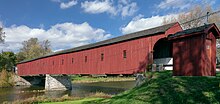
The 1,282-foot (391 m) Hartland Bridge in New Brunswick is the longest covered bridge in the world. In 1900 Quebec, New Brunswick, and Ontario had an estimated 1000, 400, and five covered bridges respectively. By the 1990s there were 98 in Quebec,[16] 62 in New Brunswick,[17] and one in Ontario, the West Montrose Covered Bridge.[18] Between 1969 and 2015, the number of surviving covered bridges in Canada dropped from about 400 to under 200.[19]
United States
According to Covered Bridges Today by Brenda Krekler, as many as 12,000 covered bridges once existed in the United States; that number dropped to under 1,500 by the 1950s.[20] The National Society for the Preservation of Covered Bridges was formed in 1950,[20] and the Federal Highway Administration (FHWA) encourages the preservation of covered bridges with its Covered Bridge Manual.[21] By 2018, less than one thousand still survived in the US.[22]
Today, covered bridges exist in many states:
- Alabama – see list of covered bridges in Alabama
- California – eleven were reported in 2002,[23] including one at Knight's Ferry[24]
- Connecticut – Two covered bridges span the Housatonic River in Litchfield County; one covered bridge spans the Salmon River in Middlesex County. See Covered Bridges in Connecticut.
- Delaware – Three bridges remain in New Castle county.
- Georgia – see list of covered bridges in Georgia (U.S. state)
- Illinois – five covered bridges remain in the state, most notably the Red Covered Bridge north of Princeton[25]
- Indiana – In 1980, Indiana was reported as having 130 extant covered bridges, with the highest number (36) in Parke County.[26] See list of covered bridges in Indiana.
- Iowa – Nineteen covered bridges were built in Iowa between 1855 and 1885; nine remain, five of which are in Madison County around Winterset (see List of covered bridges in Madison County, Iowa).[27]
- Kentucky – As many as 700 covered bridges existed in the past, though only 13 are known to still exist. 12 are open to the public and one exists on private property; all are listed on the National Register of Historic Places.[28]
- Maine – see list of covered bridges in Maine
- Maryland – six remain as of 2015[update][29]
- Michigan – see list of covered bridges in Michigan
- Missouri – see list of covered bridges in Missouri
- Minnesota – see list of covered bridges in Minnesota[30]
- Massachusetts – see list of bridges on the National Register of Historic Places in Massachusetts
- New Hampshire – At one time there were about 400 covered bridges in New Hampshire.[31] It was reported that "at the end of twentieth century there were still nearly seventy covered bridges in New Hampshire."[32] In 2006, it was reported that there are 54 surviving bridges administered by the New Hampshire Department of Transportation, the most famous being the Cornish–Windsor Covered Bridge (1866), spanning the Connecticut River from Cornish, New Hampshire to Windsor, Vermont; this bridge is the longest wooden covered bridge in the United States.[31] See list of covered bridges in New Hampshire.
- New Jersey – New Jersey had up to 35 covered bridges at its peak; many that were destroyed or damaged in various major floods are rebuilt as metal truss bridges.[33] Today, two covered bridges remain: Green Sergeant's Covered Bridge (19th century) and Scarborough Bridge (1959).[33]
- New York – see list of covered bridges in New York
- North Carolina – two remain, the Pisgah and Bunker Hill[34]
- Ohio – 142 remain, the second-highest of any state, down from over 4,000 at peak.[35] See List of covered bridges in Ohio.
- Oregon – 50 remain. See list of covered bridges in Oregon.
- Pennsylvania – about 219 remain, the most of any state.[35] See List of covered bridges on the National Register of Historic Places in Pennsylvania.
- Rhode Island[36] – see list of covered bridges in Rhode Island
- South Carolina – The only remaining covered bridge in South Carolina is Campbell's Covered Bridge in Greenville County [37]
- Tennessee – four remain as of 1980[update][38]
- Vermont – "Vermont is justly famous for her covered bridges. No other state has built and still possesses so many of the old timbered crossings in so small an area."[39] In 1996, 106 covered bridges were reported in Vermont.[40] See list of covered bridges in Vermont.
- Virginia – see list of covered bridges in Virginia
- Washington – Only a few traditional covered bridges remain in Washington.[41] Not all are publicly accessible.
- Wisconsin – The only remaining historic covered bridge in Wisconsin is the covered bridge in Cedarburg.[42][43] There is also the Smith Rapids Covered Bridge in Park Falls, but it was built in 1991.[44]
- West Virginia – see list of covered bridges in West Virginia
Other covered bridges
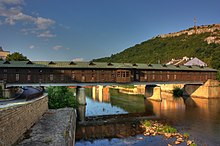
The term covered bridge is also use to describe any bridge-like structure that is covered. For example:
- The Lovech Covered Bridge in Bulgaria is covered not for structural reasons, but to accommodate shops.
- A tubular bridge is a bridge built as a rigid box girder section within which the traffic is carried.[45] Examples include the Britannia Bridge and the Conwy Railway Bridge in the United Kingdom.
- A skyway is a type of urban pedway consisting of an enclosed or covered footbridge between two buildings, designed to protect pedestrians from the weather. For example, the Bridge of Sighs in Cambridge, and Oxford's Bridge of Sighs and Logic Lane covered bridge.
- A jet bridge is an enclosed, movable connector which extends from an airport terminal gate to an airplane, allowing passengers to board and disembark without having to go outside.[46]
- Some bridges are covered to protect pedestrians or as a decoration—as with the Italian Ponte Coperto (Pavia), Ponte Vecchio (Florence) and Rialto Bridge (Venice), and the Chùa Cầu (the Japanese Bridge; see Gallery below) in Vietnam.
Covered bridges in fiction
Covered bridges are popular in folklore[47] and fiction. For example:
- North American covered bridges received much recognition as a result of the success of the 1992 novel, The Bridges of Madison County by Robert James Waller, and its film adaptation as a Hollywood motion picture starring Meryl Streep and Clint Eastwood. The film made the Roseman Covered Bridge, built in Iowa in 1883 , famous when it was featured in both the novel and the film.
- A covered bridge is prominently featured in the story "Never Bet the Devil Your Head" by Edgar Allan Poe.
- Covered bridges serve as plot points in the 1988 comedy films Beetlejuice and Funny Farm.
Gallery
-
Chùa Cầu, Japanese Covered Bridge, Hội An, Vietnam (16th-17th Century)
-
Covered Bridge at Bowie Race Track
-
Holzbrücke, Bad Säckingen
-
Kapellbrücke, Luzern
-
Oldest covered railroad bridge in the United States is located at Hopkinton, New Hampshire.
-
Corbin covered bridge over North Branch where it enters the Sugar River in Newport, NH
-
Xijin Bridge in Zhejiang, China
-
A covered bridge in West Sumatra, Indonesia (1877–1879)
-
Saya Bridge in Kotohira, Japan
-
Plank-lattice truss interior structure of Green River Bridge in Guilford, Vermont
-
Covered bridge entrance, Frankenmuth, Michigan
-
The Russein Bridge (Russeinerbrücke) in Switzerland under construction in 1857. The falsework under the bridge was removed after the bridge was finished.
-
Roseman Covered Bridge, in Madison County, Iowa
-
Ströhberne Bruck’n (Straw bridge), in Edelschrott, Austria
References
- ^ "Covered bridge". Encyclopædia Britannica. Retrieved 8 October 2012.
- ^ "West Montrose Covered Bridge – The Kissing Bridge (built in 1881)". Township of Woolwich. Archived from the original on 3 August 2015. Retrieved 16 August 2015.
{{cite web}}: Unknown parameter|deadurl=ignored (|url-status=suggested) (help) - ^ a b c "Covered Bridge Manual". U.S. Department of Transportation. Retrieved 9 October 2012.
- ^ "History/Design". Pennsylvania Covered Bridges. Retrieved 26 February 2015.
- ^ Marshall, Richard G. (1994). "Carleton Bridge". New Hampshire Covered Bridges: A Link With Our Past. Concord: New Hampshire Department of Transportation. OCLC 31182444.
{{cite book}}: External link in|chapterurl=|chapterurl=ignored (|chapter-url=suggested) (help) - ^ Kopas, Virginia (30 March 2012). "Pennsylvania is among the tops in the number of covered bridges". Pittsburgh Post-Gazette. Archived from the original on 10 October 2012. Retrieved 9 October 2012.
{{cite news}}: Unknown parameter|deadurl=ignored (|url-status=suggested) (help) - ^ "World Guide to Covered Bridges". WoodCenter.org. Iowa State University Institute for Transportation. Retrieved 9 October 2012.
- ^ "Fujian Bridges!". Amoymagic.mts.cn. 17 January 2004. Retrieved 4 January 2012.
- ^ "Museum of Ancient Bridges, Taishun County". China.org.cn. 27 June 2002. Retrieved 4 January 2012.
- ^ "Langqiao.net" (in Chinese). Archived from the original on 8 August 2007.
{{cite web}}: Unknown parameter|deadurl=ignored (|url-status=suggested) (help) - ^ "Swiss Timber Bridges".
- ^ "Historic Wooden Bridges/"Covered Bridges"". HSNB.DE. 11 July 2011. Retrieved 15 October 2018.
- ^ "Hidden Masterpieces: Covered Bridges in PA". Pennsylvania Book Center. Spring 2010. Retrieved 15 October 2018.
- ^ "Throwback Thursday: Covered bridges". Canadian Geographic. 28 May 2015. Retrieved 15 October 2018.
- ^ "Visit America's Most Idyllic Covered Bridges". Architectural Digest. December 2016. Retrieved 15 October 2018.
- ^ "Ponts couverts". Transports Quebec. Archived from the original on 24 February 2012. Retrieved 26 September 2012.
{{cite web}}: Unknown parameter|deadurl=ignored (|url-status=suggested) (help) - ^ "New Brunswick Covered Bridges". Archived from the original on 23 July 2012. Retrieved 8 October 2012.
{{cite web}}: Unknown parameter|deadurl=ignored (|url-status=suggested) (help) - ^ "West Montrose Covered Bridge". Region of Waterloo. Archived from the original on 19 January 2011. Retrieved 31 October 2009.
- ^ "Throwback Thursday: Covered bridges; Today, fewer than 200 covered bridges survive in Canada". Canadian Geographic. Retrieved 15 October 2018 1.
{{cite web}}: Check date values in:|accessdate=(help) - ^ a b Evans, Benjamin D.; Evans, June R. (2004). New England's Covered Bridges: A Complete Guide. University Press of New England. p. 10. ISBN 978-1-58465-320-2.
- ^ Covered Bridge Manual. U.S. Department of Transportation. Retrieved 28 November 2012.
- ^ "Guidelines to Restoring Structural Integrity of Covered Bridge Members" (PDF). US Department of Agriculture. 15 January 2018. p. 110.
- ^ Hoover, Mildred Brooke; Rensch, Hero Eugene; Rensch, Ethel Grace; Abeloe, William N. (2002). Kyle, Douglas E. (ed.). Historic Spots in California (5th ed.). Stanford University Press. p. 107. ISBN 978-0-8047-4482-9.
- ^ "Knights Ferry SHP: California's Longest Covered Bridge". Pashnit.com. Retrieved 28 November 2012.
- ^ Henderson, Lyndee Jobe (2010). Off the Beaten Path: Illinois, A Guide to Unique Places (10th ed.). Morris. p. 110. ISBN 978-0-7627-5025-2.
- ^ Vlach, John M. (1980). "Joseph J. Daniels and Joseph A. Britton: Parke County's Covered Bridge Builders". In Dégh, Linda (ed.). Indiana Folklore: A Reader. Indiana University Press. p. 22. ISBN 978-0-253-10986-6.
- ^ Dregni, Eric (2006). Midwest Marvels: Roadside Attractions Across Iowa, Minnesota, the Dakota, and Wisconsin. University of Minnesota Press. p. 84. ISBN 978-0-8166-4290-8.
- ^ "Kentucky's Thirteen Existing Covered Bridges". Covered Bridges in Kentucky. Retrieved 5 September 2017.
- ^ "Maryland's Six Existing Covered Bridges". Maryland Covered Bridges. Retrieved 1 July 2014.
- ^ "Covered Bridge". Zumbrota Covered Bridge. Retrieved 16 July 2014.
- ^ a b Starbuck, David R. (2006). The Archaeology of New Hampshire: Exploring 10,000 Years in the Granite State. University Press of New Hampshire. p. 153. ISBN 978-1-58465-562-6.
- ^ Belman, Felice; Pride, Mike, eds. (2001). The New Hampshire Century: Concord Monitor Profiles of One Hundred People Who Shaped It. University Press of New England. p. 209. ISBN 978-1-58465-087-4.
- ^ a b Richman, Steven M. (2005). The Bridges of New Jersey: Portraits of Garden State Crossings. Rutgers University Press. p. 92. ISBN 978-0-8135-3510-4.
- ^ Hairr, John (2007). North Carolina Rivers: Facts, Legends, and Lore. History Press. pp. 119–20. ISBN 978-1-59629-258-1.
- ^ a b Moore, Elma Lee (2010). Ohio's Covered Bridges. Arcadia Publishing. p. 7. ISBN 978-0-7385-8430-0.
- ^ "Swamp Meadow Covered Bridge". VisitRhodeIsland.com. Retrieved 11 July 2013.
- ^ "Campbell's Covered Bridge – Gowensville, South Carolina". SCIWAY. Retrieved 23 June 2016.
- ^ "Covered Bridges in Tennessee". Tennessee Department of Transportation. Retrieved 28 November 2012.
- ^ Allen, Richard Sanders (1983). Covered Bridges of the Northeast (2nd ed.). Stephen Greene Press. p. 50. ISBN 978-0-8289-0439-1.
- ^ Barna, Ed (1996). Covered Bridges of Vermont. Countryman Press. ISBN 978-0-88150-373-9.
- ^ "Washington Covered Bridge Map". www.coveredbridgemap.com. Retrieved 26 April 2018.
- ^ McKee, Brian J. (1997). Historic American Covered Bridges. ASCE Press. p. 143. ISBN 978-0-7844-0189-7.
- ^ Gierach, Ryan (2003). Cedarburg: A History Set in Stone. Acadia Publishing. p. 145. ISBN 978-0-7385-2431-3.
- ^ "Smith Rapids Covered Bridge". TravelWisconsin.com. Retrieved 16 August 2015.
- ^ Chrimes, Mike (1991). Civil Engineering, 1839–1889. London: Alan Sutton. p. 47. ISBN 1-84015-008-4.
- ^ Gesell, Laurence E (1992). The Administration of Public Airports. Chandler, AZ: Coast Aire. pp. 114–115. ISBN 0-9606874-7-5.
- ^ Dégh, Linda, ed. (1980). Indiana Folklore: A Reader. Bloomington: Indiana University. p. 42. ISBN 978-0-253-20239-0.
{{cite book}}: Unknown parameter|editorlink=ignored (|editor-link=suggested) (help)
External links
- Covered Bridge Security Manual United States Forest Service
- Use of Laser Scanning Technology to Obtain As-Built Records of Historic Covered Bridges United States Forest Service
- "Covered Spans of Yesteryear", documenting the current and former covered bridges of the United States and Canada
- National Society for the Preservation of Covered Bridges
- Covered Bridge Map, an interactive map showing locations of covered bridges in the United States and Canada
- Template:Fr icon "Les ponts couverts au Québec, héritage précieux"[permanent dead link], an article on covered bridges in Quebec




